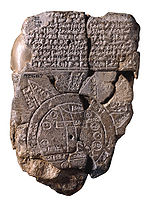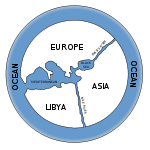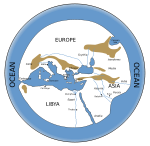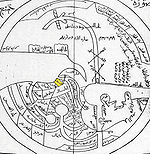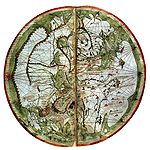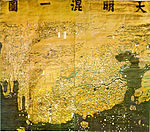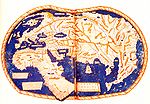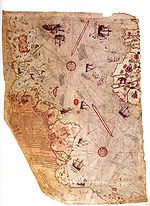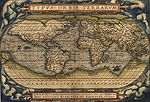- Early world maps
-
 Ptolemy's world map (2nd century) in a 15th century reconstruction
Ptolemy's world map (2nd century) in a 15th century reconstruction
Early world maps cover depictions of the world from the Iron Age to the Age of Discovery and the emergence of modern geography during the early modern period.
Antiquity
Babylonian Imago Mundi (c. 600 BCE)
Main article: Babylonian Map of the WorldImago Mundi Babylonian map, the oldest known world map, 6th century BCE Babylonia.
A Babylonian world map, known as the Imago Mundi, is commonly dated to the 6th century BCE.[1][2] The map as reconstructed by Eckhard Unger shows Babylon on the Euphrates, surrounded by a circular landmass showing Assyria, Urartu[3] and several cities, in turn surrounded by a "bitter river" (Oceanus), with seven islands arranged around it so as to form a seven-pointed star. The accompanying text mentions seven outer regions beyond the encircling ocean. The descriptions of five of them have survived[4]:
- the third island is where "the winged bird ends not his flight," i.e., cannot reach.
- on the fourth island "the light is brighter than that of sunset or stars": it lay in the northwest, and after sunset in summer was practically in semi-obscurity.
- The fifth island, due north, lay in complete darkness, a land "where one sees nothing," and "the sun is not visible."
- the sixth island, "where a horned bull dwells and attacks the newcomer"
- the seventh island lay in the east and is "where the morning dawns."
Anaximander (c. 610 – 546 BCE)
Anaximander (died ca. 546 BCE) is credited with having created one of the first maps of the world,[5] which was circular in form and showed the known lands of the world grouped around the Aegean Sea at the center. This was all surrounded by the ocean.
Hecataeus of Miletus (c. 550 – 476 BCE)
Hecataeus of Miletus (died ca. 476 BCE) is credited with a work entitled Ges Periodos ("Travels round the Earth" or "World Survey'), in two books each organized in the manner of a periplus, a point-to-point coastal survey. One on Europe, is essentially a periplus of the Mediterranean, describing each region in turn, reaching as far north as Scythia. The other book, on Asia, is arranged similarly to the Periplus of the Erythraean Sea of which a version of the 1st century CE survives. Hecataeus described the countries and inhabitants of the known world, the account of Egypt being particularly comprehensive; the descriptive matter was accompanied by a map, based upon Anaximander’s map of the earth, which he corrected and enlarged. The work only survives in some 374 fragments, by far the majority being quoted in the geographical lexicon Ethnika compiled by Stephanus of Byzantium.
Eratosthenes (276 – 194 BCE)
Eratosthenes (276-194 BCE) drew an improved world map, incorporating information from the campaigns of Alexander the Great and his successors. Asia became wider, reflecting the new understanding of the actual size of the continent. Eratosthenes was also the first geographer to incorporate parallels and meridians within his cartographic depictions.
Posidonius (c. 150 – 130 BCE)
 A 1628 reconstruction of Posidonius ideas about the positions of continents (many details couldn't have been known by Posidonius)
A 1628 reconstruction of Posidonius ideas about the positions of continents (many details couldn't have been known by Posidonius) Main article: Posidonius
Main article: PosidoniusPosidonius (or Poseidonius) of Apameia (c. 135 BCE - 51 BCE), was a Greek stoic philosopher[7] who traveled throughout the Roman world and beyond and was a celebrated polymath throughout the Greco-Roman world, like Aristotle and Eratosthenes. His work "about the ocean and the adjacent areas", was an overall representation of geographical questions to show how all the forces had an effect on each other and applied also to human life. He measured the Earth's circumference by reference to the position of the star Canopus. His measure of 240,000 stadia translates to 24,000 miles, close to the actual circumference of 24,901 miles.[8] He was informed in his approach by Eratosthenes, who a century earlier used the elevation of the sun at different latitudes. Both men's figures for the Earth's circumference were uncannily accurate, aided in part in each case by mutually compensating errors in measurement. However, the version of Posidonius' calculation popularised by Strabo was revised by correcting the distance between Rhodes and Alexandria to 3,750 stadia, resulting in a circumference of 180,000 stadia, or 18,000 miles.[9] Ptolemy discussed and favored this revised figure of Posidonius over Eratosthenes in his Geographia, and during the Middle Ages scholars divided into two camps regarding the circumference of the earth, identified with Eratosthenes' calculation on the one hand and Posidonius' 180,000-stadium measure on the other.
Strabo (c.64 BCE – 24 CE)
Main articles: Strabo and GeographicaStrabo is mostly famous for his 17-volume work Geographica, which presented a descriptive history of people and places from different regions of the world known to his era.[10] The Geographica first appeared in Western Europe in Rome as a Latin translation issued around 1469. Although Strabo referenced the antique Greek astronomers Eratosthenes and Hipparchus and acknowledged their astronomical and mathematical efforts towards geography, he claimed that a descriptive approach was more practical. Geographica provides a valuable source of information on the ancient world, especially when this information is corroborated by other sources. Within the books of Geographica is a map of Europe. Whole world maps according to Strabo are reconstructions from his written text.
Pomponius Mela (c. 43 CE)
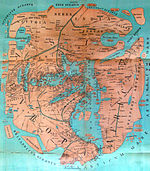 An 1898 reconstruction of Pomponius Melas view of the World.
An 1898 reconstruction of Pomponius Melas view of the World. Main article: Pomponius Mela
Main article: Pomponius MelaPomponius is unique among ancient geographers in that, after dividing the earth into five zones, of which two only were habitable, he asserts the existence of antichthones, people inhabiting the southern temperate zone inaccessible to the folk of the northern temperate regions from the unbearable heat of the intervening torrid belt. On the divisions and boundaries of Europe, Asia and Africa, he repeats Eratosthenes; like all classical geographers from Alexander the Great (except Ptolemy) he regards the Caspian Sea as an inlet of the Northern Ocean, corresponding to the Persian and Arabian (Red Sea) gulfs on the south.
Marinus of Tyre (c. 120)
Main article: Marinus of TyreMarinus of Tyre's world maps were the first in the Roman Empire to show China. Around 120 A.D., Marinus wrote that the habitable world was bounded on the west by the Fortunate Islands. The text of his geographical treatise however is lost. He also invented the equirectangular projection, which is still used in map creation today. A few of Marinus' opinions are reported by Ptolemy. Marinus was of the opinion that the Okeanos was separated into an eastern and a western part by the continents (Europe, Asia and Africa). He thought that the inhabited world stretched in latitude from Thule (Shetland) to Agisymba (Tropic of Capricorn) and in longitude from the Isles of the Blessed to Shera (China). Marinus also coined the term Antarctic, referring to the opposite of the Arctic Circle. His chief legacy is that he first assigned to each place a proper latitude and longitude; he used a "Meridian of the Isles of the Blessed (Canary Islands or Cape Verde Islands)" as the zero meridian.
Ptolemy (c. 150)
The Ptolemy world map is a map based on the description of the world contained in Ptolemy's book Geographia, written Circa 150. Although authentic maps of Ptolemy have never been found, the Geographia contains thousands of references to various parts of the old world, with coordinates for most, which seem to have influenced early Islamic maps, and allowed European cartographers to reconstruct Ptolemy's world view when an ancient Greek manuscript was translated into Latin around 1300.
Tabula Peutingeriana (4th century)
The Tabula Peutingeriana (Peutinger table) is an itinerarium showing the cursus publicus, the road network in the Roman Empire. It is a 13th century copy of an original map dating from the 4th century, covering Europe, parts of Asia (India) and North-Africa. The map is named after Konrad Peutinger, a German 15-16th century humanist and antiquarian. The map was discovered in a library in Worms by Conrad Celtes, who was unable to publish his find before his death, and bequeathed the map in 1508 to Peutinger. It is conserved at the Österreichische Nationalbibliothek, Hofburg, Vienna.
Tabula Peutingeriana, from Iberia in the west, to India in the east.
Middle Ages
 World map by Cosmas Indicopleustes
World map by Cosmas Indicopleustes
Cosmas Indicopleustes' map (6th century)
Around 550 Cosmas Indicopleustes wrote the copiously illustrated Christian Topography, a work partly based on his personal experiences as a merchant on the Red Sea and Indian Ocean in the early 6th century. Though his cosmogony is refuted by modern science, he has given a historic description of India and Sri Lanka during of the 6th century, which is invaluable to historians. Cosmas seems to have personally visited the Kingdom of Axum in modern Ethiopia and Eritrea, India and Sri Lanka. In 522 CE, he visited the Malabar Coast (South India). A major feature of his Topography is Cosmas' worldview that the world is flat, and that the heavens form the shape of a box with a curved lid, a view he took from unconventional interpretations of Christian scripture. Cosmas aimed to prove that pre-Christian geographers had been wrong in asserting that the earth was spherical and that it was in fact modelled on the tabernacle, the house of worship described to Moses by God during the Jewish Exodus from Egypt.
Isidore of Sevilla's T and O map (c. 636)
Main article: T and O mapThe medieval T and O maps originate with the description of the world in the Etymologiae of Isidore of Sevilla (died 636). This qualitative and conceptual type of medieval cartography represents only the top-half of a spherical Earth.[11] It was presumably tacitly considered a convenient projection of the inhabited portion of the world known in Roman and Medieval times (that is, the northern temperate half of the globe). The T is the Mediterranean, dividing the three continents, Asia, Europe and Africa, and the O is the surrounding Ocean. Jerusalem was generally represented in the center of the map. Asia was typically the size of the other two continents combined. Because the sun rose in the east, Paradise (the Garden of Eden) was generally depicted as being in Asia, and Asia was situated at the top portion of the map.
Ibn Hawqals map (10th century)
Main article: Ibn HawqalIbn Hawqal was an Arab scientist of the 10th century who developed a world map, based on his own travel experience and probably the works of Ptolemy. Another such cartographer was Al-Istakhri.[12]
Anglo-Saxon Cotton world map (c. 1040)
This map appears in a copy of a classical work on geography, the Latin version by Priscian of the Periegesis, that was among the manuscripts in the Cotton library (MS. Tiberius B.V., fol. 56v), now in the British Library. It is not intended purely as an illustration to that work, for it contains much material gathered from other sources, including some which would have been the most up-to-date available, although it is based on a distant Roman original (similar to the source of another 11th century world map, illustrating an edition of Isidore of Seville)- on which the network of lines appears to indicate the boundaries of imperial provinces. The date of drawing was formerly estimated at about CE 992-994, based on suggested links to the journey of Archbishop Sigeric of Canterbury from Rome[13] but more recent analysis indicates that, although the information was revised about that time, the map was probably drawn between 1025 and 1050.[14]
Like the later map by al-Idrisi (see below) this map is clearly outside the largely symbolic early medieval mapping tradition, but equally it is not based on the famous Ptolemaic co-ordinate system. East is at the top, but Jerusalem is not in the centre, and the Garden of Eden is nowhere to be seen. Unusually, all the waterways of Africa, not just the Red Sea, are depicted in red (mountains are green). The depiction of the far East is ambitious, including India and Taprobane (Sri Lanka)- the latter depicted according to the exaggerated classical conception of its size. Unsurprisingly, Britain itself is depicted in some detail. Great Britain, unusually by medieval standards, is shown as one island, albeit with an exaggerated Cornish promontory, and Mona, Ireland and the many Scottish islands are all indicated. The cartographer is slightly confused by Iceland, depicting it both by a version of its classical name 'Thule', north-west of Britain, and as 'Island', logically linked with Scandinavia.
 World map from the Saint-Sever Beatus
World map from the Saint-Sever Beatus
Beatus Mappa Mundi (1050)
Main article: Beatus of LiébanaBeatus of Liébana (c. 730 - 798) was a Spanish monk and theologian. He corresponded with Alcuin, and took part in the Adoptionist controversy, criticizing the views of Felix of Urgel and Elipandus of Toledo. He is best remembered today as the author of his Commentary on the Apocalypse, published in 776. An illustrated manuscript known as the Saint-Sever Beatus, featuring the Commentary, was produced around 1050 at the Abbey of Saint-Sever, Aquitaine, France. It contains one of the oldest Christian world maps as an illustration of the Commentary. Although the original manuscript and map has not survived, copies of the map survives in several of the extant manuscripts.
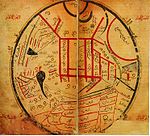 al-Kashgari's Diwanu Lughat at-Turk.
al-Kashgari's Diwanu Lughat at-Turk.
Mahmud al-Kashgari's map (1072)
Qarakhanid Uyghur scholar Mahmud al-Kashgari compiled a "Compendium of the languages of the Turks" in the 11th century. The manuscript is illustrated with a "Turkocentric" world map, oriented with east (or rather, perhaps, the direction of midsummer sunrise) on top, centered on the ancient city of Balasagun in what is now Kyrgyzstan, showing the Caspian Sea to the north, and Iraq, Azerbaijan, Yemen and Egypt to the west, China and Japan to the east, Hindustan, Kashmir, Gog and Magog to the south. Conventional symbols are used throughout- blue lines for rivers, red lines for mountain ranges etc. The world is shown as encircled by the ocean.[15] The map is now kept at the Pera Museum in Istanbul.
 The Tabula Rogeriana (1154).
The Tabula Rogeriana (1154).
Al-Idrisi's Tabula Rogeriana (1154)
Main article: Tabula RogerianaThe Arab geographer, Muhammad al-Idrisi, incorporated the knowledge of Africa, the Indian Ocean and the Far East gathered by Arab merchants and explorers with the information inherited from the classical geographers to create the most accurate map of the world at the time. It remained the most accurate world map for the next three centuries. The Tabula Rogeriana was drawn by Al-Idrisi in 1154 for the Norman King Roger II of Sicily, after a stay of eighteen years at his court, where he worked on the commentaries and illustrations of the map. The map, written in Arabic, shows the Eurasian continent in its entirety, but only shows the northern part of the African continent.
 The Ebstorf Map, ca. 1235.
The Ebstorf Map, ca. 1235.
Ebstorf Mappa Mundi (1235)
Main article: Ebstorf MapThe Ebstorf Map is an example of a European mappa mundi, made by Gervase of Ebstorf, who was possibly the same man as Gervase of Tilbury,[16] some time in the thirteenth century. It is a very large map: painted on 30 goatskins sewn together, it measures about 3.6m x 3.6m. The head of Christ is depicted at the top of the map, with his hands on either side and his feet at the bottom.[17] The Map is a Y-shaped map, rather than the more common medieval tripartite or T and O map, it is centered on Jerusalem with east on top of the map. It represents Rome in the shape of a lion, and has an evident interest in the distribution of bishropics.[18] The orighinal was destroyed during World War II but some color copies remain.
 The Hereford Mappa Mundi, ca. 1300
The Hereford Mappa Mundi, ca. 1300
Hereford Mappa Mundi (1300)
Main article: Hereford Mappa MundiThe Hereford Mappa Mundi is a detailed mappa mundi based on the T and O map style, dating to ca. 1300. The map is signed by one "Richard of Haldingham or Lafford". Drawn on a single sheet of vellum, it measures 158 cm by 133 cm. The writing is in black ink, with additional red and gold, and blue or green for water (with the Red Sea coloured red). The captions demonstrate clearly the multiple functions of these large medieval maps, conveying a mass of information on Biblical subjects and general history, in addition to geography.
Jerusalem is drawn at the centre of the circle, east is on top, showing the Garden of Eden in a circle at the edge of the world (1). Great Britain is drawn at the northwestern border (bottom left, 22 & 23). Curiously, the labels for Africa and Europe are reversed, with Europe scribed in red and gold as 'Africa', and vice-versa.
Pietro Vesconte's world map (1321)
Italian geographer Pietro Vesconte was a pioneer of the field of the portolan chart. His nautical charts are among the earliest to map the Mediterraean and Black Sea regions accurately. He also produced progressively more accurate depictions of the coastlines of northern Europe. In his world map of 1321 he brought his experience as a maker of portolans to bear; the map introduced a previously unheard of accuracy to the mappa mundi genre.[19] The world map, as well as a map of the Holy Land and plan of Acre and Jerusalem were made for inclusion in Marino Sanuto's Liber secretorum fidelium cruces.[20]
 Two leaves of The Catalan world atlas
Two leaves of The Catalan world atlas
Catalan World Atlas (1375)
Main article: Catalan AtlasThe Catalan World Atlas was produced by the Majorcan cartographic school and is attributed to Cresques Abraham. It has been in the royal library of France (now the Bibliothèque nationale de France) since the time of Charles V. The Catalan Atlas originally consisted of 6 vellum leaves folded down the middle painted in various colors including gold and silver. The first two leaves contain texts in Catalan language covering cosmography, astronomy, and astrology. These texts are accompanied by illustrations. The texts and illustration emphasize the Earth's spherical shape and the state of the known world. They also provide information to sailors on tides and how to tell time at night.
Unlike many other nautical charts, the Catalan Atlas is read with the north at the bottom. As a result of this the maps are oriented from left to right, from the Far East to the Atlantic. The first two leaves, forming the oriental portion of the Catalan Atlas, illustrate numerous religious references as well as a synthesis of medieval mappae mundi (Jerusalem located close to the centre) and the travel literature of the time, notably Marco Polo's Book of Marvels and the Travels and Voyage of Sir John Mandeville. Many Indian and Chinese cities can be identified.
Da Ming Hun Yi Tu world map (1389)
Main article: Da Ming Hun Yi TuChina developed sophisticated mapping techniques at about the same time as ancient Rome, and never lost them, so by the "medieval" period the country had been mapped with considerable detail and accuracy (see Chinese geography). When European mapping techniques caught up again at about CE 1300, Islamic contacts were able to supply new maps of the Mediterranean area to China, via the communication routes in the Mongol empire, and these prompted Chinese scholars to create world maps, with China at the centre and Europe, half-way round the globe, depicted very small and horizontally compressed at the edge. Significantly, Africa was also mapped from an Indian Ocean perspective, showing the Cape of Good Hope area, which Europeans would not visit until much later. The first examples, made in the 1320s, are lost, so the earliest survivor is the elaborate, colourful Da Ming Hun Yi Tu, painted on 17 sq. m. of silk in 1389 for the first Ming emperor.
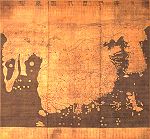 Kangnido world map (1402)
Kangnido world map (1402)
Kangnido world map (1402)
Main article: KangnidoThe Kangnido (the full Hanja name means "Map of Integrated Lands and Regions of Historical Countries and Capitals")[21] is a map of the world made in Korea in 1402. Created under the supervision of Korean officials as part of a cultural project of the newly founded Joseon Dynasty,[22] it is the most familiar example of the known-world maps based on Chinese cartographic techniques with additional input from western sources, via Islamic scholarship in the Mongol Empire. Superficially similar to the Da Ming Hun Yi Tu (which has been less well known in the West because it is kept in closed archive storage) the Kangnido shows its Korean origin in the enlargement of that country, and incorporates vastly improved (though wrongly positioned, scaled and oriented) mapping of Japan. Elsewhere, the map betrays a decorative rather than practical purpose, particularly in the portrayal of river systems, which form unnatural loops rarely seen on Chinese maps. Nonetheless, it is considered as "superior to anything produced in Europe prior to the end of the fifteenth century".[23]
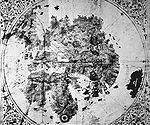 De Virga world map (1411–1415)
De Virga world map (1411–1415)
De Virga world map (1411-1415)
Main article: De Virga world mapThe De Virga world map was made by Albertinus de Virga between 1411 and 1415. Albertin de Virga, a Venetian, is also known for a 1409 map of the Mediterranean, also made in Venice. The world map is circular, drawn on a piece of parchment 69.6x44 cm. It consists of the map itself, about 44 cm in diameter, and an extension containing a calendar and two tables.
 Bianco world map (1436)
Bianco world map (1436)
Bianco's world map (1436)
Main article: Bianco world mapAndrea Bianco's atlas of 1436 comprises ten leaves of vellum, measuring 29 X 38 cm., in an 18th century binding. The first leaf contains a description of the Rule of Marteloio for resolving the course, with the "circle and square", two tables and two other diagrams. The next eight leaves contain various navigation charts. The ninth leaf contains a circular world map measuring 25 cm in circumference. And the final leaf contains the Ptolemaic world map on Ptolemy's first projection, with graduation. Some believe Bianco's maps were the first to correctly portray the coast of Florida, as a macro-peninsula is attached to a large island labeled Antillia. Bianco also collaborated with Fra Mauro on the Fra Mauro world map of 1459.
Genoese map (1457)
Main article: Genoese mapThe Genoese map of 1457 is a world map that relied extensively on the account of the traveler to Asia Niccolo da Conti, rather than the usual source of Marco Polo.[24] The author is unknown, but is a more modern development than the Fra Mauro world map, less intricate a complete, with fairly good proportions given to each continents. The map depicts the main landmarks of the time: Prester John in Africa, the Great Khan in China, "Xilam" (Ceylom) and Sumatra, and the design of a three-masted European ship in the Indian Ocean, something which had not occurred, suggesting that a sealane was a possibility.[25]
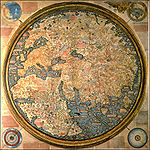 Fra Mauro map (1459)
Fra Mauro map (1459)
Fra Mauro world map (1459)
Main article: Fra Mauro mapThe Fra Mauro map was made between 1457 and 1459 by the Venetian monk Fra Mauro. It is a circular planisphere drawn on parchment and set in a wooden frame, about 2 meters in diameter. The original world map was made by Fra Mauro and his assistant Andrea Bianco, a sailor-cartographer, under a commission by king Afonso V of Portugal. The map was completed on April 24, 1459, and sent to Portugal, but did not survive to the present day. Fra Mauro died the next year while he was making a copy of the map for the Seignory of Venice, and the copy was completed by Andrea Bianco.
Martellus world map (1490)
The world map of Henricus Martellus Germanus (Heinrich Hammer), c. 1490, was remarkably similar to the terrestrial globe later produced by Martin Behaim in 1492, the Erdapfel. Both show heavy influences from Ptolemy, and both possibly derive from maps created around 1485 in Lisbon by Bartolomeo Columbus. Although Martellus is believed to have been born in Nuremberg, Behaim's home town, he lived and worked in Florence from 1480 to 1496.
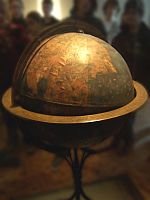 Behaim's Erdapfel
Behaim's Erdapfel
Behaim's Erdapfel globe (1492)
Main article: ErdapfelThe Erdapfel (German: earth apple) produced by Martin Behaim in 1492 is considered to be the oldest surviving terrestrial globe. It is constructed of a laminated linen ball reinforced with wood and overlaid with a map painted by Georg Glockendon[26]. The Americas are not included yet, as Columbus returned to Spain no sooner than March 1493. It shows a rather enlarged Eurasian continent and an empty ocean between Europe and Asia. Interestingly, the Caribbean islands may already be represented as well, even before Colombus's return, under the name of the mythical St. Brendan's Island. Japan and Asian islands are disproportionately large.The idea to call the globe "apple" may be related to the Reichsapfel ("Imperial Apple", Globus cruciger) which was also kept in Nuremberg along with the Imperial Regalia (Reichskleinodien). In 1907, it was transferred to the Germanic Museum in Nuremberg.
After 1492
Further information: Age of DiscoveryJuan de la Cosa map (1500)
 Map of Juan de la Cosa, shown rotated right (in the original manuscript north points left), 1500
Map of Juan de la Cosa, shown rotated right (in the original manuscript north points left), 1500 Main article: Map of Juan de la Cosa
Main article: Map of Juan de la CosaThe Juan de la Cosa, a Spanish cartographer, explorer and conquistador, born in Santoña in the northern autonomous region of Cantabria, made several maps of which the only survivor is the Mappa Mundi of 1500. It is the first known European cartographic representation of the Americas. It is now in the Museo Naval in Madrid. Reproductions of it are given by Humboldt in his Atlas géographique et physique.
Cantino world map (1502)
Main article: Cantino planisphereThe Cantino planisphere or Cantino world map is the earliest surviving map showing Portuguese discoveries in the east and west. It is named after Alberto Cantino, an agent for the Duke of Ferrara, who successfully smuggled it from Portugal to Italy in 1502. It shows the islands of the Caribbean and the Florida coastline, as well as Africa, Europe and Asia. The map is particularly notable for portraying a fragmentary record of the Brazilian coast, discovered in 1500 by Portuguese explorer Pedro Álvares Cabral who conjectured whether it was merely an island [27] or part of the continent that several Spanish expeditions had just encountered farther north (cf. Amerigo Vespucci). The Cantino planisphere is the earliest known map incorporating observed latitudes, following the introduction of astronomical navigation, in the last quarter of the fifteenth century.
Caverio Map (c.1505)
Main article: Caverio mapThe Caverio Map, also known as Caveri Map or Canerio Map, is a map drawn by Nicolay de Caveri, circa 1505. It is hand drawn on parchment and coloured, being composed of ten sections or panels, measuring 2.25 by 1.15 metres. Historians believe that this undated map signed with "Nicolay de Caveri Januensis" was completed in 1504-05. It was probably either made in Lisbon by the Genoese Canveri, or copied by him in Genoa from the very similar Cantino map. It shows the east coast of North America with surprising detail and was one of the primary sources used to make the Waldseemüller map in 1507. Caverio map is currently at Bibliothèque Nationale de France in Paris.
Ruysch World Map (1507)
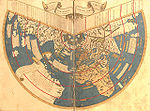 Ruysch's 1507 map of the world
Ruysch's 1507 map of the world
Johannes Ruysch an explorer, cartographer, astronomer and painter from the Low Countries produced the second oldest known printed representation of the New World.[28] The Ruysch map was published and widely distributed in 1507. It uses Ptolemy's coniform projection, as does the Contarini-Rosselli 1506 map. Both document Christopher Columbus' discoveries as well as that of John Cabot, including information from Portuguese sources and Marco Polo's account. There are notes on his map that clearly were from Portuguese sources. Newfoundland and Cuba are shown connected to Asia, as Columbus and Cabot believed. “Sipganus” (Marco Polo’s Japan) is identical with “Spagnola” (Hispaniola) on the Ruysch map. The presence of codfish is noted on the Ruysch map in the area of the Grand Banks of Newfoundland and shows the discoveries the Portuguese had made along the African coast and shows India as a triangular peninsula with Ceylon in the correct proportion and position. Greenland is shown connected to Newfoundland and Asia on Ruysch's map, and not Europe as earlier maps had showed. Around the north pole, Ruysch drew islands, based on reports in the book Inventio Fortunata of the English friar Nicholas of Lynne. Interestingly, the island above Norway shows remarkable similarities to Svalbard, which would not be discovered until 1597 (by Willem Barents). Ruysch calls it 'European Hyberborea' and a peninsula stretching out towards it is clearly marked with the church of 'Sancti Odulfi', St Olaf's church in Vardø on the Finnmark coast.
Waldseemüller and Ringmann map (1507)
 Waldseemüller map with joint sheets, 1507
Waldseemüller map with joint sheets, 1507 Main article: Waldseemüller map
Main article: Waldseemüller mapThe cartographers Martin Waldseemüller and Matthias Ringmann from southern Germany, supported by the mapping friend René II, Duke of Lorraine, collected map data over several years, including information on the most recent discoveries, to build up a new collective work of geography and cartography. Along with a book they further incorporated, for the first time in history, the name America on a map, holding the strong opinion that it was a new continent that Amerigo Vespucci had discovered on his voyage and not only a few smaller islands as Christopher Columbus did in the West Indies. The great richness and high grade of detail of the resulting map speak for themselves.
Piri Reis map (1513)
Main article: Piri Reis mapThe Piri Reis map is a famous world map created by 16th century Ottoman Turkish admiral and cartographer Piri Reis. The surviving third of the map shows part of the western coasts of Europe and North Africa with reasonable accuracy, and the coast of Brazil is also easily recognizable. Various Atlantic islands including the Azores and Canary Islands are depicted, as is the mythical island of Antillia. The map is noteworthy for its apparent south-eastward extension of the American continent to depict a southern landmass that some controversially claim is evidence for early awareness of the existence of Antarctica. Alternatively, it has been suggested that this is actually a record of the coast as far as Cape Horn, explored secretly by Portuguese navigators before 1507 (when it appeared on the Waldseemüller map) and bent south-eastward simply to fit on the parchment.
Pietro Coppo map (1520)
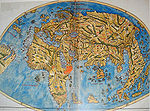 Map of Pietro Coppo, Venice, 1520
Map of Pietro Coppo, Venice, 1520
One of the last world maps to feature the "Dragon's Tail" extending southwards from the far eastern extremity of Asia, the last vestige of Ptolemy's landlocked depiction of the Indian Ocean, nearly 1,500 years earlier.
Diogo Ribeiro map (1527)
 World Map by Diogo Ribeiro, "Propaganda map" (1529), Biblioteca Apostolica Vaticana
World Map by Diogo Ribeiro, "Propaganda map" (1529), Biblioteca Apostolica Vaticana
Diogo Ribeiro, a Portuguese cartographer working for Spain, made what is considered the first scientific world map: the 1527 Padrón real, the first world map based on empiric latitude observations. There are 6 copies attributed to Ribeiro, including at the Weimar Grand Ducal Library (1527 Mundus Novus) and at the Biblioteca Apostolica Vaticana, in Vatican City (1529 Propaganda Map or Carta Universal).[29] The layout of the map (Mapamundi) is strongly influenced by the information obtained during the Magellan-Elcano trip around the world. Diogo's map delineates very precisely the coasts of Central and South America. However, neither Australia nor Antarctica appear, and the Indian subcontinent is too small. The map shows, for the first time, the real extension of the Pacific Ocean. It also shows, for the first time, the North American coast as a continuous one (probably influenced by the Esteban Gómez's exploration in 1525). It also shows the demarcation of the Treaty of Tordesillas.
Mercator world map (1569)
Main articles: Mercator Projection and Gerardus Mercator Mercator Nova et Aucta Orbis Terrae Descriptio, 1569
Mercator Nova et Aucta Orbis Terrae Descriptio, 1569
Flemish geographer and cartographer Gerardus Mercator world map of 1569 introduced a cylindrical map projection that became the standard map projection known as the Mercator projection. It was a large planisphere measuring 202 by 124 cm, printed in eighteen separate sheets. While the linear scale is constant in all directions around any point, thus preserving the angles and the shapes of small objects (which makes the projection conformal), the Mercator projection distorts the size and shape of large objects, as the scale increases from the Equator to the poles, where it becomes infinite. The name and explanations given by Mercator to his world map (Nova et Aucta Orbis Terrae Descriptio ad Usum Navigatium Emendate: "new and augmented description of Earth corrected for the use of navigation") show that it was expressly conceived for the use of marine navigation. The development of the Mercator projection represented a major breakthrough in the nautical cartography of the 16th century.
"Theatrum Orbis Terrarum" by Abraham Ortelius (1570)
Main article: Theatrum Orbis TerrarumThe Theatrum Orbis Terrarum or "Theatre of the World") is considered to be the first true modern atlas. Written by Abraham Ortelius and originally printed on May 20, 1570, in Antwerp, it consisted of a collection of uniform map sheets and sustaining text bound to form a book for which copper printing plates were specifically engraved. The Ortelius atlas is sometimes referred to as the summary of sixteenth-century cartography. Many of his atlas' maps were based upon sources that no longer exist or are extremely rare. Ortelius appended a unique source list (the "Catalogus Auctorum") identifying the names of contemporary cartographers, some of whom would otherwise have remained obscure. Three Latin editions of this (besides a Dutch, a French and a German edition) appeared before the end of 1572; twenty-five editions came out before Ortelius' death in 1598; and several others were published subsequently, for the atlas continued to be in demand till about 1612. This is the world map from this atlas.
"Nova totius Terrarum Orbis" by Hendrik Hondius (1630)
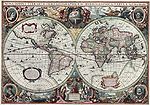 Nova totius Terrarum by Hendrik Hondius, 1630, State Library of New South Wales
Nova totius Terrarum by Hendrik Hondius, 1630, State Library of New South Wales
Nova totius Terrarum Orbis geographica ac hydrographica tabula is a map of the world created by Hendrik Hondius in 1630, and published the following year at Amsterdam, in the atlas Atlantis Maioris Appendix.[30] Among its claims to notability is the fact that it was the first dated map published in an atlas, and therefore the first widely available map, to show any part of Australia, the only previous map to do so being Hessel Gerritsz' 1627 Caert van't Landt van d'Eendracht ("Chart of the Land of Eendracht"), which was not widely distributed. The Australian coastline shown is part of the west coast of Cape York Peninsula, discovered by Jan Carstensz in 1623. Curiously, the map does not show the west coast features shown in Gerritsz' Caert.
See also
- Here be dragons
- History of cartography
- Johannes Schöner globe, made in 1520.
- Mappa mundi
- Nebra sky disk, a Bronze Age "map" of the cosmos.
- Terra Incognita
- The "Zheng He map", a world map dated to the 18th century but claimed to be a copy of an early 15th century map.
- Vinland Map, a 15th century map of disputed authenticity
- Web mapping
- World map
- Jambudvipa, a geographic idea originated in India.
Notes
- ^ Siebold, Jim Slide 103 via henry-davis.com - accessed 2008-02-04
- ^ First published 1899, formerly also dated to an earlier period, ca. 900 BCE. Kurt A. Raaflaub & Richard J. A. Talbert (2009), Geography and Ethnography: Perceptions of the World in Pre-Modern Societies, John Wiley & Sons, p. 147, ISBN 1405191465
- ^ http://www.jstor.org/pss/1151277 IMAGO MVNDI, Vol.48 pp.209
- ^ Finel, Irving (1995). A join to the map of the world: A notable discover. pp. 26–27.
- ^ Timechart of historical cartography: Antiquity
- ^ Source
- ^ Encyclopaedia Britannica "Greek philosopher, considered the most learned man of his time and, possibly, of the entire Stoic school."
- ^ Poseidonius, fragment 202
- ^ Brown, Lloyd Arnold The Story of Maps Dover Publications (1979) pp29-31
- ^ Strabonis Geographica, Book 17, Chapter 7.
- ^ Michael Livingston, Modern Medieval Map Myths: The Flat World, Ancient Sea-Kings, and Dragons, 2002.
- ^ The History of cartography by John Brian Harley, David Woodward p.120ff
- ^ Siebold, Jim Slide 210 monograph: Cottoniana or Anglo-Saxon Map, via henry-davis.com - accessed 2008-02-04
- ^ British Library Collect Britain, accessed 2008-03-14
- ^ 81 - The First Turkish World Map, by Kashgari (1072) « Strange Maps
- ^ Gervase of Tilbury, Otia Imperialia, (Oxford Medieval Texts), Oxford, 2002, p. xxxiv.
- ^ Evelyn Edson (1997), p. 138
- ^ Gervase of Tilbury, Otia Imperialia, (Oxford Medieval Texts), Oxford, 2002, p. xxxv
- ^ http://www.henry-davis.com/MAPS/LMwebpages/228Fmono.html
- ^ http://books.google.com/books?id=uJaP4i7-_MIC&pg=RA2-PA432&dq=%22perrino+vesconte%22#v=snippet&q=vesconte&f=false
- ^ Choson Korea in the Ryukoku Kangnido- via IngentaConnect
- ^ BIMCC conference abstract- accessed 2008-03-16
- ^ Peter Jackson, "The Mongols and the West", p.330
- ^ Peter Whitfield New Found Lands: Maps in the History of Exploration, p.36, Routledge, 1998 ISBN 0415920264
- ^ Whitfield, p.36
- ^ Behaim Globe at Bayern-online
- ^ Letter of Pero Vaz de Caminha, beijo as maãos de vosa alteza. deste porto seguro da vosa jlha da vera cruz (see original letter in archaic Portuguese, in the Portuguese Wikisource project): I kiss Your Majesty's Hands, from this safe haven of your island of Vera Cruz
- ^ Ruysch World Map: Census and Commentary, Donald L. McGuirk, Jr. Imago Mundi, Vol. 41, 1989 (1989), pp. 133-141
- ^ "Carta Universal" (slide description, Ribeiro bio), Henry-Davis.com, webpage: HDav346.
- ^ Copy belonging to the State Library of New South Wales. Access to it is available at [1]
External links
- Index of Maps of the Early Medieval Period 400-1300 A.D
- Mapping History - a learning resource from the British Library
- Geography And Map Reading Room at the Library of Congress
- Ancient World Maps
Atlas Atlas · Cartography · Geography · Map · Map projection · Topography
Early world maps · History of cartography · List of cartographers
Cartogram · Choropleth map · Geologic map · Linguistic map · Nautical chart · Pictorial maps · Thematic map · Topographic map · Weather map
Find a map by geographic area or typeCategories:- Maps
- Old maps of the world
- Cartography
- Atlas
- History of geography
Wikimedia Foundation. 2010.

